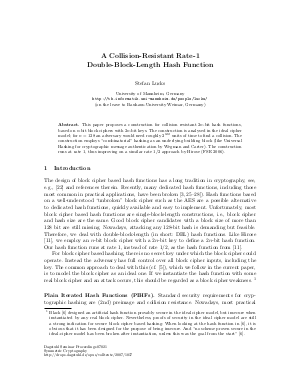A Collision-Resistant Rate-1 Double-Block-Length Hash Function
Author Stefan Lucks
-
Part of:
Volume:
Dagstuhl Seminar Proceedings, Volume 7021
Part of: Series: Dagstuhl Seminar Proceedings (DagSemProc) - License:
 Creative Commons Attribution 4.0 International license
Creative Commons Attribution 4.0 International license
- Publication Date: 2007-06-06
File

PDF
DagSemProc.07021.3.pdf
- Filesize: 247 kB
- 14 pages
Document Identifiers
Subject Classification
Keywords
- Hash function
- provable security
- double-block-length
Metrics
- Access Statistics
-
Total Accesses (updated on a weekly basis)
0Document
0Metadata
Abstract
This paper proposes a construction for collision resistant
$2n$-bit hash functions, based
on $n$-bit block ciphers with $2n$-bit keys. The construction is analysed
in the ideal cipher model; for $n=128$ an adversary would need roughly
$2^{122}$ units of time to find a collision.
The construction employs ``combinatorial'' hashing
as an underlying building block (like
Universal Hashing for cryptographic
message authentication by Wegman and Carter).
The construction runs at rate~1, thus improving on a similar
rate~1/2 approach by Hirose (FSE 2006).
Cite As Get BibTex
Stefan Lucks. A Collision-Resistant Rate-1 Double-Block-Length Hash Function. In Symmetric Cryptography. Dagstuhl Seminar Proceedings, Volume 7021, pp. 1-14, Schloss Dagstuhl – Leibniz-Zentrum für Informatik (2007)
https://doi.org/10.4230/DagSemProc.07021.3
BibTex
@InProceedings{lucks:DagSemProc.07021.3,
author = {Lucks, Stefan},
title = {{A Collision-Resistant Rate-1 Double-Block-Length Hash Function}},
booktitle = {Symmetric Cryptography},
pages = {1--14},
series = {Dagstuhl Seminar Proceedings (DagSemProc)},
ISSN = {1862-4405},
year = {2007},
volume = {7021},
editor = {Eli Biham and Helena Handschuh and Stefan Lucks and Vincent Rijmen},
publisher = {Schloss Dagstuhl -- Leibniz-Zentrum f{\"u}r Informatik},
address = {Dagstuhl, Germany},
URL = {https://drops.dagstuhl.de/entities/document/10.4230/DagSemProc.07021.3},
URN = {urn:nbn:de:0030-drops-10172},
doi = {10.4230/DagSemProc.07021.3},
annote = {Keywords: Hash function, provable security, double-block-length}
}
